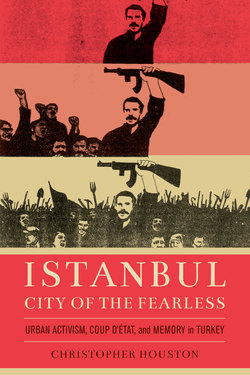Читать книгу Istanbul, City of the Fearless - Christopher Houston - Страница 12
На сайте Литреса книга снята с продажи.
Оглавление3
De-Ottomanization,
Modernism, Migration
A Selective History of Istanbul, 1923–1974
As one of the great cities of the planet, Istanbul has properly been the subject of a vast body of writing. A proportion of it sits on shelves in the Greater Istanbul Municipality bookshop beside the funicular railway exit in Galata, groaning under the weight of local histories of each of the city’s older neighborhoods, supplemented by exegeses of their representations in a thousand and one novels, songs, films, and poems. More recently established suburbs are less well celebrated. Almost every issue of any Middle East journal reviews new material on Istanbul’s social history, provisioning, political institutions, labor relations, socio-spatial differentiation, sexual practices, religious governance, architecture, consumption habits, sartorial dress, and aesthetic traditions, from any of its many ages. Then there are the centuries of writings from its own inhabitants and of travelers from eastern and western origins, captivated or overwhelmed by its size and complexity.
Sedimented with the detritus of two empires and dense with Muslim and non-Muslim places, four hundred fifty years of Ottoman rule resulted in a peninsula dotted with buildings, fountains, mosques, libraries, and so on, inscribing in place the benevolence and power of the dynasty.
To spite this endless archive, in this third chapter I want to compose from a range of sources a selective history of the “violence of architecture” in Istanbul from the founding of the Turkish Republic in 1923 up until the mid-1970s.1 In so doing, I hope to give the reader some idea of the origins and frictional development of the city’s key morphology and environments that a multitude of political activists in the late 1970s sought to control or revolutionize. What was Istanbul, theater and crucible of political conflict, like in 1974, and how did it get to be like that? Radically remade through neoliberal economic policies in the decades after the 1980 coup, Istanbul is a city whose built environment in the nineteenth century alone had already been reassembled by world-scale processes, both by reforms in institutional practices of government and by escalating flows of European capital that greatly extended the city’s urban footprint in the late-Ottoman years. After the establishment of the Republic, four processes transformed Istanbul again: first, a nationalist project aimed at the expulsion of its non-Muslim population (Aktar 2000); second, modernist urban planning initiatives, new architecture, and Marshall-plan money; third, on-again, off-again state policies of national developmentalism that characterized not just the first fifty years of the Republic (1929–1979) but a global system of partially self-regulating and only “banally” different nation-states (Keyder 1987); and fourth, mass migration that swelled its population, size, workforce, and wealth.
